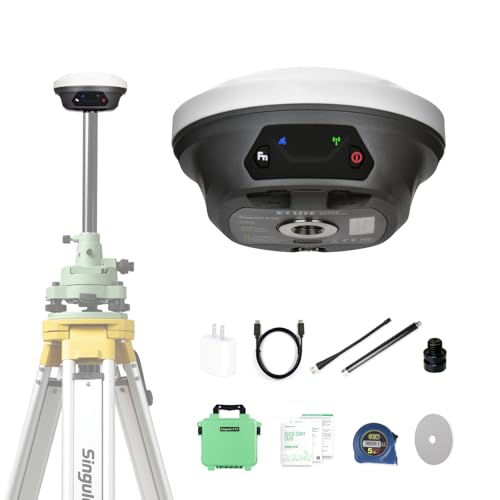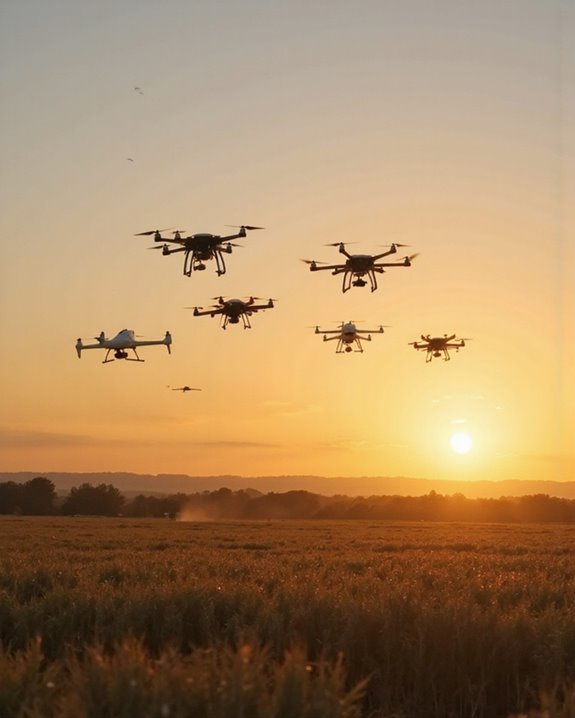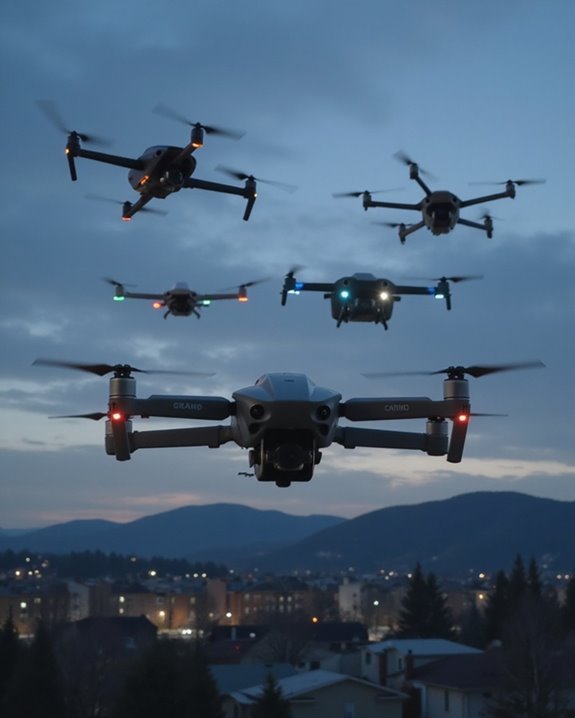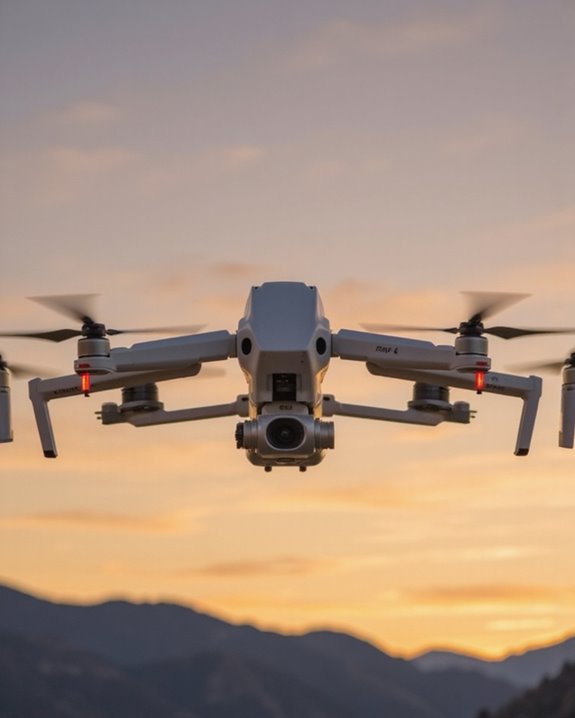For effective drone surveying, you’ll need quality equipment that balances accuracy with usability. The best setups include drones with 4K cameras and 3-axis gimbals like the Potensic ATOM or Bwine F7, plus reliable GCP markers for precise measurements. Look for features like extended flight times (60+ minutes), centimeter-level accuracy, and compatibility with mapping software such as Pix4D. Don’t forget accessories like stakes and storage options! The right combination will transform your aerial mapping projects from good to groundbreaking.
Key Takeaways
- Professional surveying drones should offer at least 30 minutes of flight time for efficient data collection in large areas.
- Ideal surveying drones need 4K cameras with stabilized gimbals to capture high-resolution imagery for accurate mapping.
- RTK-enabled drones provide centimeter-level accuracy crucial for precise surveying and mapping applications.
- Software compatibility with Pix4D and DroneDeploy is essential for processing aerial imagery into usable survey data.
- Ground Control Points (GCPs) significantly improve mapping accuracy when used with surveying drones.
Sky High Bulls-Eye Disposable Ground Control Points for Aerial Mapping (100 Pack)
- PERFECT SIZE - 18" x 18" disposable aerial targets with a matte finish reduces glare from the sun and maintains high visitbility for your ground control point (GCP) needs
- BLACK & WHITE - Standard black and white checkerboard pattern is compatible with most photogrammetry software such as Pix4D, DroneDeploy, and other software with...
- CENTER HOLE - Use the center hole for aligning measurement equipment for precision mapping without causing creases and tears in the drone target so that you can get...
Professional surveyors and drone mapping enthusiasts, you’ll love these high-visibility GCPs that take the headache out of accurate aerial mapping! The 18×18-inch black and white checkerboard pattern guarantees maximum visibility from above, while the matte finish reduces glare for crystal-clear imagery.
You’ll appreciate the clever design features, including center holes for 60D nails or mag spikes, plus corner holes for extra anchoring on windy days. They’re compatible with Pix4D, DroneDeploy, and all major drone mapping software. The bonus package includes 500 wooden stakes and a carrying bag—talk about value! With a 4.5-star rating, these disposable targets offer an economical alternative to DIY solutions, perfect for remote locations where efficiency matters.
Best For: Professional surveyors, drone mapping specialists, and GIS professionals who need reliable, visible ground control points for accurate aerial mapping projects in various field conditions.
Pros:
- Includes 500 wooden stakes and carrying bags for easy field transport and deployment, especially valuable for remote locations
- Matte finish reduces glare while the black/white checkerboard pattern ensures high visibility and software recognition
- Multiple anchoring options including center and corner holes provide stability in windy conditions
Cons:
- Package weight of 8.6 kilograms may be cumbersome for individuals working alone in the field
- Single-use disposable design creates potential waste compared to reusable alternatives
- Limited customer reviews (only 2 ratings) makes reliability assessment difficult for potential buyers
Bwine F7 GPS Drone with 4K Camera and 3-Axis Gimbal
No products found.
The Bwine F7 GPS Drone stands out as a surveyor’s dream with its impressive 75-minute flight time, allowing you to capture extensive terrain without constantly returning to base. You’ll appreciate the FAA-compliant design, complete with remote ID on the drone arm and QR code for hassle-free operation.
The 4K camera with 3-axis gimbal delivers rock-solid footage even in challenging conditions, while the 120° FOV lens guarantees you won’t miss a detail. With impressive specs like 2000m altitude capability and 3000m control range, you’re equipped for serious surveying work! The drone’s intelligent features—GPS auto-return, follow me, and flight path programming—make complex mapping tasks surprisingly simple. Who knew professional-grade aerial surveying could be this accessible?
Best For: Surveyors, mappers, and aerial photography enthusiasts seeking a professional-grade drone with exceptional flight time and stable 4K footage capabilities for extensive terrain coverage.
Pros:
- Impressive 75-minute total flight time with three batteries allows for extended surveying sessions without frequent returns to base
- Professional-quality imaging with 4K camera, 3-axis gimbal stabilization, and night vision capabilities
- FAA-compliant with built-in safety features like GPS auto-return and impressive 3000m control range
Cons:
- Long battery charging time of 6-7 hours may require planning ahead for continuous use
- No mention of obstacle avoidance technology which is important for surveying in complex environments
- May have a steeper learning curve for beginners despite the smart features due to its professional-grade capabilities
Potensic ATOM 4K GPS Drone with 3-Axis Gimbal
- 【𝐋𝐢𝐠𝐡𝐭𝐰𝐞𝐢𝐠𝐡𝐭, 𝐥𝐞𝐬𝐬 𝐭𝐡𝐚𝐧 𝟐𝟒𝟗𝐠】 The palm-sized drone, ATOM, 𝐝𝐨𝐞𝐬𝐧'𝐭...
- 【𝐑𝐨𝐜𝐤 𝐒𝐭𝐞𝐚𝐝𝐲 𝟒𝐊 𝟑-𝐀𝐱𝐢𝐬 𝐆𝐢𝐦𝐛𝐚𝐥】Equipped with 𝐒𝐎𝐍𝐘 𝐂𝐌𝐎𝐒...
- 【𝟏.𝟑𝐇 𝐅𝐚𝐬𝐭 𝐂𝐡𝐚𝐫𝐠𝐞, 𝟗𝟔 𝐌𝐢𝐧𝐬 𝐋𝐨𝐧𝐠 𝐅𝐥𝐢𝐠𝐡𝐭 𝐰𝐢𝐭𝐡 𝟑...
Hobbyist drone pilots looking for exceptional image stability in a compact package will find their match in the Potensic ATOM 4K GPS Drone. Weighing under 249g, you won’t need FAA registration for this palm-sized powerhouse! The drone features a professional-grade 3-axis gimbal with SONY CMOS sensor that delivers stunning 4K/30fps video even in windy conditions.
You’ll love the impressive 96-minute flight time from three included batteries and the convenient 60W charging hub. The 6km transmission range keeps you connected while creative QuickShots like Boomerang and Spiral make your aerial photography look effortlessly professional. Released in October 2023, this aluminum-constructed drone comes complete with everything you need—even a 64GB micro SD card!
Best For: Enthusiast photographers and videographers seeking a portable, FAA registration-free drone that delivers professional-quality 4K footage with excellent stabilization and extended flight time.
Pros:
- Exceptional flight time of 96 minutes using the three included batteries and convenient 60W charging hub
- Professional-grade imaging with 3-axis gimbal, SONY CMOS sensor, and 4K/30fps video capability even in windy conditions
- Lightweight design under 249g eliminates FAA registration requirements while still offering impressive 6km transmission range
Cons:
- Premium features come with a higher price point compared to entry-level drones
- Compact size may make it more susceptible to stronger winds despite gimbal stabilization
- May have a steeper learning curve for absolute beginners despite being marketed as beginner-friendly
Drone with Camera for Adults, 2K HD FPV with Altitude Hold
- 【2K Ultra HD Camera】Loiley drone features a high-quality 2K HD camera with a 90° remote adjustable angle, allowing you to capture breathtaking photos and ultra-clear...
- 【User-friendly & Optical Flow Positioning】 The Loiley drone operation is magically simple—press the one-touch start/land button to begin flying. With headless mode...
- 【Take it with you】 Loiley drone with camera is your ultimate travel partner! It is small and lightweight, and the size is only 5 x 3 x 2 inches when folded, which can...
Drone enthusiasts seeking professional-quality aerial photography will find their perfect match in Loiley’s 2K HD camera drone! You’ll capture stunning footage with its 90° adjustable camera angle and real-time FPV view that connects directly to your smartphone. Share your aerial masterpieces instantly on social media!
Its user-friendly features make flying a breeze—one-key takeoff/landing, headless mode, and altitude hold guarantee stable flights even for beginners. At just under 250g and folding down to pocket size (5 x 3 x 2 inches), you won’t need FAA registration. With two batteries providing 26 minutes of total flight time and built-in safety features, you’re all set for adventure!
Best For: Beginning drone enthusiasts and casual photographers looking for an affordable, portable, and user-friendly drone to capture aerial photos and videos without FAA registration requirements.
Pros:
- Lightweight and highly portable design that folds down to 5 x 3 x 2 inches, making it easy to carry in pockets or backpacks
- User-friendly flight controls including one-key takeoff/landing, headless mode, and altitude hold features that help beginners maintain stable flight
- 2K HD camera with 90° adjustable angle provides good quality imagery with real-time smartphone connectivity for immediate sharing
Cons:
- Limited flight time of only 6-8 minutes per battery (though two batteries are included)
- At 1.15 pounds total package weight, it may be affected by wind conditions more than heavier professional drones
- While marketed as having “ultra-clear” videos, the 2K resolution falls short of the 4K capabilities found in higher-end photography drones
Drone Ground Control Point GCP Markers for Mapping & Surveying (4 Pack)
- Efficient Surveying GCP: The UAV GCP adopts a black white color scheme to provide optimal visibility. The color scheme enhances target exposure, ensuring clearer images...
- Excellent Aerial Survey Target: The center opening design makes it easy to directly insert the column to locate the coordinate measurement, or aim the drone camera at the...
- Hole Design GCP: The center hole designed on this UAV GCP makes it easy to quickly identify the center of the GCP through the surveying equipment rod to avoid tearing the...
Professional surveyors know that accuracy makes all the difference between usable data and costly mistakes! These black and white GCP markers provide the perfect solution with their 24×24 inch size, visible from altitudes up to 400 feet.
You’ll love how the checkerboard pattern works with automatic recognition software, saving you precious time in the field. The center opening lets you insert your survey rod directly through the marker—genius! With PVC coating and polyester mesh construction, you won’t deal with glare issues that plague DIY solutions.
The corner holes let you secure these markers for repeated flights, meaning you’ll gather consistent data without repositioning. Your drone mapping just got a major upgrade!
Best For: Professional surveyors and drone operators requiring high-precision ground control points for accurate mapping, photogrammetry, and construction site documentation at altitudes up to 400 feet.
Pros:
- Durable PVC coating with polyester mesh construction provides weather resistance and eliminates glare issues common in DIY alternatives
- Standard black and white checkerboard pattern is compatible with automatic recognition software, increasing efficiency in data processing
- Center opening and corner holes allow for precise positioning with survey rods and secure anchoring for consistent data across multiple flights
Cons:
- Limited to 400-foot altitude visibility, which may not be suitable for higher-altitude mapping projects
- Requires physical deployment and collection in the field, adding time to surveying operations
- Four-pack quantity may be insufficient for larger survey areas requiring numerous control points
E1 Lite RTK Base Station – High Accuracy GNSS GPS Receiver for Surveying
- 【High-Precision Surveying】The E1 Lite GNSS RTK delivers centimeter-level accuracy with its full-constellation GNSS support, ensuring reliable performance for land...
- 【Fast Fixed Solutions】E1 gnss survey equipment achieve fixed solutions within seconds, even in challenging environments like urban canyons, dense tree canopies, and...
- 【Affordable & Cost-Effective】Designed for professionals on a budget, the E1 Lite RTK offers an exceptional cost-to-performance ratio, making high-precision surveying...
When centimeter-level precision makes all the difference in your mapping projects, the E1 Lite RTK Base Station stands out as a game-changing solution for budget-conscious surveyors. You’ll get full-constellation GNSS support with fixed solutions in seconds, even in tricky spots like urban canyons and dense tree coverage.
This little powerhouse doesn’t skimp on connectivity either, featuring NFC, Bluetooth, WiFi, and USB-C options with 8GB onboard storage. Its IP67 rating means you won’t panic when those surprise rain clouds appear! You’ll need a permanent SingularPad license for rover mode, and U.S. users should note the FCC license requirement for commercial UHF operation.
Best For: Land surveyors, drone mapping professionals, and field researchers who need centimeter-level positioning accuracy without breaking their equipment budget.
Pros:
- Delivers centimeter-level accuracy with full-constellation GNSS support, even in challenging environments like urban canyons and dense tree coverage
- Features comprehensive connectivity options including NFC, Bluetooth, WiFi, and USB-C with 8GB onboard storage for flexible data management
- IP67-rated dust and waterproof construction ensures durability and reliable performance in harsh outdoor conditions
Cons:
- Requires purchase of a permanent SingularPad license for rover mode functionality, adding to the total cost of ownership
- U.S. users must apply for an additional FCC radio license for commercial UHF operations (450-470 MHz)
- May require specialized training to fully utilize all advanced signal processing capabilities and operational modes
Holy Stone GPS Drone with 4K UHD Camera (HS360S)
- Extremely Lightweight, No FAA or Remote ID Registration: HS360S, drone with camera for adults featuring the Holy Stone latest design, weighs less than 250g; this GPS...
- 4K UHD Camera with GalaxyCore Sensor: Holy Stone drones with camera for adults 4K equipped with 1/3'' CMOS GalaxyCore Sensor and 4K 85° wide-angle Camera adjusted within...
- Advanced Connection Technology: HS360S, a GPS drone with camera, features Holy Stone's enhanced remote controller. Now you can connect your smartphone to the controller...
For hobbyists and casual surveyors wanting to avoid FAA paperwork hassles, the Holy Stone HS360S offers a perfect entry point into drone surveying! Weighing under 250g, you’ll skip the Remote ID registration while still enjoying impressive 4K UHD video capabilities through its GalaxyCore Sensor.
You’ll appreciate the extended 10,000-foot control range and real-time image streaming via 5G transmission, making small survey projects a breeze. The GPS positioning keeps your flight paths stable, while safety features like auto-return protect your investment. When you’re ready to get creative, the intelligent recording modes—Spiral Up, Catapult, and 1-Tap Ascension—add flair to your aerial footage!
Best For: Hobbyist photographers and beginner drone enthusiasts who want a lightweight, registration-free drone with quality 4K video capabilities for casual aerial photography and basic surveying projects.
Pros:
- Weighs under 250g, requiring no FAA Remote ID registration while still offering 4K UHD camera functionality
- Impressive 10,000-foot control range with 5G transmission for real-time image streaming
- Multiple intelligent flight modes (Spiral Up, Catapult, Follow Me) that enhance creative recording options
Cons:
- Limited 20-minute flight time may restrict longer surveying sessions or extended photography projects
- 85° camera angle is narrower than professional survey drones, potentially limiting field of view for comprehensive site mapping
- While suitable for casual projects, lacks the advanced sensors and stability features needed for professional-grade surveying work
Ground Control Point (GCP) Markers for Drone Mapping & Surveying (6 Pack)
- High-quality Aerial Survey Target: This drone control point GCP is not only a precise aerial calibration mark, but also a high-contrast ground reference point. The center...
- Hole Design GCP: The center hole designed on this UAV GCP makes it easy to quickly identify the center of the GCP through the surveying equipment rod to avoid tearing the...
- Efficient Surveying GCP: The UAV GCP adopts a black white color scheme to provide optimal visibility. The color scheme enhances target exposure, ensuring clearer images...
Ground Control Point (GCP) markers are the secret weapon that transforms your drone mapping from good to exceptional! These 24×24 inch markers feature a clever center pass-through design that allows for precise coordinate measurement right at the marker’s center. You’ll appreciate the thoughtful construction—PVC-coated polyester mesh with a matte finish that reduces glare, making them visible up to 400 feet in the air.
The standard checkerboard pattern works seamlessly with most photogrammetry software, while corner holes let you secure them firmly in place. No more wasting time repositioning between flights! They’re lightweight, travel-ready, and far more cost-effective than DIY solutions. Your survey data just got a major accuracy upgrade!
Best For: Professional drone surveyors and mapping specialists who need to improve the accuracy of their aerial data collection with durable, high-visibility reference points.
Pros:
- Center pass-through design enables precise coordinate measurement at the exact center point, significantly improving mapping accuracy
- Visible up to 400 feet with a glare-reducing matte finish and high-contrast black-white pattern that’s automatically recognized by most photogrammetry software
- Durable PVC-coated polyester mesh construction with secure corner holes for anchoring, allowing for repeated flights without repositioning
Cons:
- 24×24 inch size might be challenging to transport in large quantities for extensive survey projects
- May require additional anchoring solutions in windy conditions despite the included corner holes
- Initial investment cost higher than DIY alternatives, though more cost-effective long-term
Potensic ATOM SE GPS Drone with 4K Camera for Adults
- 【𝐋𝐢𝐠𝐡𝐭𝐰𝐞𝐢𝐠𝐡𝐭 𝐚𝐧𝐝 𝐋𝐞𝐯𝐞𝐥-𝟓 𝐖𝐢𝐧𝐝 𝐑𝐞𝐬𝐢𝐬𝐭𝐚𝐧𝐜𝐞】ATOM SE drone weighs...
- 【𝟒𝐊 𝐄𝐈𝐒 𝐂𝐚𝐦𝐞𝐫𝐚 𝐰𝐢𝐭𝐡 𝐒𝐨𝐧𝐲 𝐒𝐞𝐧𝐬𝐨𝐫】The drone is equippied with a 𝟏/𝟑’’...
- 【𝐁𝐞𝐠𝐢𝐧𝐧𝐞𝐫 𝐅𝐫𝐢𝐞𝐧𝐝𝐥𝐲, 𝐒𝐮𝐫𝐠𝐞𝐅𝐥𝐲 𝐅𝐥𝐞𝐱𝐢𝐛𝐥𝐞...
Drone enthusiasts seeking professional-quality aerial surveying without FAA registration hassles will find their perfect match in the Potensic ATOM SE. This pocket-sized powerhouse weighs under 249g and captures stunning 4K video with its Sony CMOS sensor. You’ll love how the ShakeVanish technology delivers crystal-clear footage even on breezy days!
With impressive 62-minute total flight time (thanks to dual batteries) and a robust 4KM transmission range, you’re equipped for serious surveying missions. The drone’s intelligent flight modes, including Waypoint and Follow Me, make complex mapping tasks surprisingly simple. Who knew professional-grade aerial surveying could fit in your jacket pocket?
Best For: Hobbyist photographers and content creators who want professional-quality aerial footage without the hassle of FAA registration, offering portability and extended flight time for capturing outdoor adventures.
Pros:
- Lightweight (under 249g) and foldable design eliminates FAA registration requirements while maintaining portability for travel or outdoor excursions
- Impressive 62-minute total flight time with two included batteries provides extended shooting sessions without frequent recharging
- 4K camera with Sony sensor and ShakeVanish stabilization technology delivers high-quality, steady footage even in windy conditions
Cons:
- 4KM transmission range claim may be optimistic in real-world conditions with obstacles or interference
- Limited to 12MP photos, which may not satisfy professional photographers requiring higher resolution stills
- Plastic construction, while keeping weight down, might be less durable against crashes compared to premium drone models
Sky High Bulls-Eye Drone Ground Control Point GCP for Mapping & Surveying (10 Pack)
- RELIABLE & ACCURATE - Our ground markers are a must-have for professionals looking to upgrade their drone mapping surveying equipment to achieve pinpoint accuracy in...
- USER-FRIENDLY CENTER PASSTHROUGH DESIGN - Sky High Bull's Eye drone surveying ground control points/aerial targets come in a pack of 10 and are numbered 0-9 for easy...
- CHECKERBOARD DESIGN FOR AUTODETECTION - Our checkerboard GCPs are compatible with leading mapping software such as Pix4D and DroneDeploy, allowing you to streamline your...
When accuracy becomes your top priority in surveying projects, the Sky High Bulls-Eye Drone Ground Control Point GCP pack delivers exceptional precision that professionals can’t afford to miss. Each marker features a matte finish that reduces sunlight glare, making center selection during post-processing a breeze!
You’ll love how these numbered markers (0-9) fold to 12×12 inches and fit perfectly in your camera backpack. The clever center passthrough accommodates existing survey stakes, while corner grommets keep everything secure in the field. They’re visible from 150-200 feet up and compatible with popular software like Pix4D and DroneDeploy. Despite occasional reports of off-center eyelets, these weather-resistant markers will serve you reliably across construction, agriculture, and mapping projects.
Best For: Surveying and mapping professionals who need precise ground control points for drone imaging across construction, agriculture, and crash reconstruction applications.
Pros:
- Matte finish reduces glare and improves center detection accuracy in post-processing software
- Foldable 12×12 design with numbered markers (0-9) fits easily in camera bags and includes grommets for secure field placement
- Compatible with industry-standard software like Pix4D and DroneDeploy, visible from 150-200 feet altitude
Cons:
- Some units reported to have quality control issues with off-center eyelets
- Requires placement at least 20 feet apart for optimal functionality
- Limited to 10 markers per pack, which may be insufficient for larger surveying projects
Factors to Consider When Choosing Drone Surveying
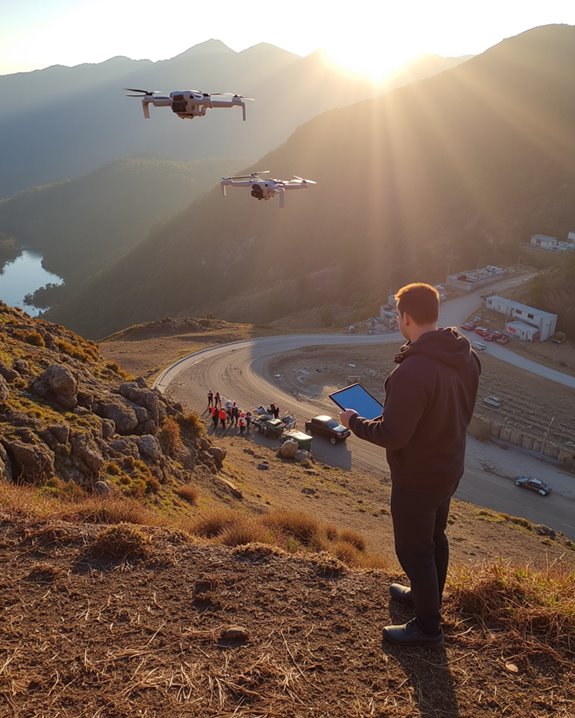
Choosing the right drone for your surveying needs isn’t just about finding the shiniest gadget with the most buttons—it’s about matching your specific requirements with the right technical capabilities! You’ll need to weigh several key factors, including accuracy requirements for your project, battery life that won’t leave you stranded mid-survey, camera resolution that captures the detail you need, proper GCP setup for geo-referencing, and compatible data processing software. These considerations will make the difference between collecting usable, professional-grade survey data and wasting your time with equipment that can’t deliver the precision your projects demand.
Accuracy Requirements
Precision is the cornerstone of every successful drone survey project! When you’re mapping terrain or measuring property boundaries, you’ll need centimeter-level accuracy to guarantee your data is reliable. For those high-stakes projects, don’t skimp on ground control points—these fixed reference markers dramatically reduce the positional errors your drone’s GPS might introduce.
If you’re working in urban environments or areas with dense tree cover, you’ll want equipment that achieves fixed solutions within seconds. Signal interference won’t stand a chance! Consider your flight altitude carefully; operations up to 400 feet often provide that sweet spot between coverage and detail. And here’s a pro tip: select drones with full-constellation GNSS support to tap into multiple satellite systems simultaneously. Your survey accuracy will thank you, and so will your clients!
Battery Life Tradeoffs
Managing the battery life equation remains one of the most essential balancing acts in drone surveying! When you’re eyeing those extended flight times, remember that bigger batteries mean heavier drones and reduced payload capacity for your equipment. You’ll face the classic “time vs. power” dilemma – do you want faster flights that drain power quickly, or slower, more methodical surveys that maximize your air time?
Those windy days present another challenge, as your drone burns through power fighting the elements. Many surveyors (the clever ones!) opt for multiple battery setups, allowing quick swaps between flights. Yes, you’ll spend a few minutes on the ground changing batteries, but it’s better than watching your drone make an emergency landing in someone’s rosebush! The right battery strategy transforms good surveys into great ones.
Camera Resolution Options
Why do so many surveyors overlook camera resolution when selecting their perfect drone? It’s a critical component that directly impacts your project’s success!
When you’re capturing aerial data, resolution determines what details you’ll actually see. For basic surveying needs, 720p might work, but you’ll miss those small objects that often matter most. Most professionals find 1080p offers that sweet spot between manageable file sizes and quality for medium-scale projects.
For serious surveying work, you’ll want to step up to 4K or higher. At these resolutions, you can measure features down to centimeters, perfect for topographic mapping or infrastructure inspection. Yes, your processing time will increase with those larger files, but the precision gain is worth it! Remember, the resolution you choose today determines the insights you’ll discover tomorrow.
GCP Setup Considerations
How you position your ground control points can make or break your entire drone survey! Opt for GCPs sized between 18-24 inches, which strike the perfect balance for visibility at altitudes up to 400 feet. You’ll want to choose targets with a matte finish to avoid those pesky sun glares that can throw off your post-processing accuracy.
Don’t forget about stability—GCPs with center and corner holes allow you to anchor them securely with stakes, which is a lifesaver on those unexpectedly windy days! The classic checkerboard pattern isn’t just for show; it helps your photogrammetry software automatically recognize targets, saving you precious time. For ideal coverage, try spacing your GCPs about 20 feet apart. Trust me, your mapping accuracy will thank you!
Data Processing Software
The right software can transform your messy drone data into survey gold! When selecting your processing solution, prioritize packages that offer automatic ground control point recognition. This feature will save you hours of tedious manual marking, especially when you’re working with standard visual patterns like checkerboards.
Your software should handle flights at various altitudes (up to the FAA’s 400-foot ceiling) without breaking a sweat. The best tools let you conduct multiple flights without repositioning those pesky ground markers—talk about a productivity boost! Look for programs that deliver centimeter-scale precision, even when your drone captures challenging environments like dense tree canopies or urban canyons. Remember, the difference between adequate and exceptional survey results often comes down to your software’s ability to interpret what your drone sees!
Weather Resistance Capabilities
Weather conditions won’t wait for your perfect survey day, which is why your drone’s resistance to the elements matters tremendously! Look for models with robust IP ratings like IP67, which shield your investment from both dust particles and unexpected downpours that could otherwise ground your operations.
Your ideal surveying companion should handle level 6 winds without breaking a sweat, ensuring those essential measurements don’t drift off course. Consider drones with matte-finished components that reduce sunlight glare—your eyes will thank you when you’re squinting at the monitor on bright days! The best models also incorporate clever features like automatic return functions triggered by sudden weather changes. This weatherproofing isn’t just about protection; it’s what enables you to tackle challenging environments like urban canyons and dense foliage without losing signal integrity!
Regulatory Compliance Standards
Maneuvering the complex web of drone regulations can feel like threading a needle while riding a roller coaster, but your surveying success depends on it! You’ll need to earn that remote pilot certificate by acing the knowledge test—no shortcuts here, folks!
Remember to keep your drone under 400 feet above ground level, or you might find yourself waving apologetically to commercial pilots! Your surveying drone must comply with Remote ID requirements too, broadcasting its location data like a proud, airborne town crier. Don’t forget to register drones over 250 grams—that $1,000+ fine could put a serious dent in your project budget! Always check for no-fly zones and temporary restrictions before launch, as airports and sensitive areas are definite no-go territories. Compliance isn’t just about avoiding penalties—it’s about professional responsibility!
RTK vs. PPK
Deciding between RTK and PPK technology feels like choosing between instant gratification and delayed reward, with each offering distinct advantages for your drone surveying projects!
RTK delivers impressive centimeter-level accuracy in real-time, allowing you to make on-the-spot adjustments during flights—even in challenging environments like urban canyons or beneath dense tree canopies. You’ll appreciate how RTK achieves fixed solutions within seconds, supporting full-constellation GNSS without the waiting game that PPK requires.
While PPK demands post-processing after you’ve packed up your drone, RTK’s immediate precision makes it perfect for time-sensitive tasks where every minute counts. Your budget will thank you too, as RTK provides high-accuracy results without the additional post-flight resources that PPK typically needs. For professionals who value efficiency, RTK’s real-time capabilities simply can’t be beat!
Frequently Asked Questions
How Long Does Drone Surveying Training Typically Take?
By Jove, you’re asking about a truly modern skill! Drone surveying training typically takes 2-4 weeks for basic certification courses, but you’ll need 3-6 months to become truly proficient in the field. Many professionals combine online learning with hands-on flight practice, which accelerates your progress. Remember, FAA certification (Part 107) is mandatory and takes about 2 weeks to prepare for. The more complex the surveying techniques you’re learning, the longer your training journey!
Can Drones Survey Accurately in Windy Conditions?
Yes, modern drones can survey accurately in windy conditions, but there are limitations. You’ll find that most professional surveying drones handle winds up to 20-25 mph effectively, thanks to advanced stabilization systems and GPS technology. Your results will suffer in stronger gusts, though! For best accuracy, you’ll want to schedule your drone surveys during calmer weather windows, especially when precision measurements are vital. Some high-end models offer impressive wind resistance, but they’ll still burn through battery life faster when fighting the breeze.
What Software Integrates Best With Drone Surveying Data?
You’ll find several excellent software options for your drone survey data! Pix4D and DroneDeploy are industry leaders, offering seamless processing capabilities and intuitive interfaces. For engineering projects, Autodesk ReCap integrates perfectly with your CAD workflows, while Agisoft Metashape excels at photogrammetry precision. Don’t overlook ArcGIS for GIS professionals who need robust spatial analysis tools! The best choice ultimately depends on your specific application, budget, and whether you need specialized features like volume calculations or vegetation analysis.
Are Specialized Licenses Required for Commercial Drone Surveying?
Yes, you definitely need specialized licenses for commercial drone surveying! The FAA requires a Part 107 Remote Pilot Certificate for any drone operations that generate income. You’ll need to pass an aeronautical knowledge test and undergo background screening. Some states or municipalities may require additional permits, especially for surveying work. Don’t forget project-specific permissions too – surveying certain properties or restricted areas might require special clearances. Getting properly licensed isn’t just legal compliance, it’s essential for insurance coverage!
How Frequently Should Drone Surveying Equipment Be Calibrated?
You’ll want to calibrate your drone surveying equipment regularly, typically before each flight day! For maximum accuracy, calibrate your compass and IMU systems every 2-3 weeks, while camera sensors and gimbal systems should be checked monthly. After any crash, repair, or firmware update, immediate recalibration is essential. Many professional surveyors follow manufacturer guidelines but adopt a more frequent schedule for mission-critical projects. Remember, proper calibration directly impacts your data quality and project success!






